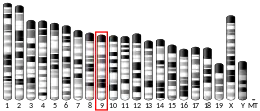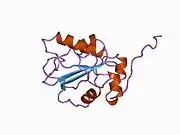CDC25A
M-phase inducer phosphatase 1 also known as dual specificity phosphatase Cdc25A is a protein that in humans is encoded by the cell division cycle 25 homolog A (CDC25A) gene.
Function
CDC25A is a member of the CDC25 family of dual-specificity phosphatases.
Dual-specificity protein phosphatases remove phosphate groups from phosphorylated tyrosine and serine / threonine residues. They represent a subgroup of the tyrosine phosphatase family (as opposed to the serine/threonine phosphatase family).
All mammals examined to date have three homologues of the ancestral Cdc25 gene (found e.g. in the fungus species S. pombe), designated Cdc25A, Cdc25B, and Cdc25C. In contrast, some invertebrates harbour two (e.g., the Drosophila proteins String and Twine) or four (e.g., C. elegans Cdc-25.1 - Cdc-25.4) homologues. CDC25A is required for progression from G1 to the S phase of the cell cycle, but also plays roles in later cell cycle events. In particular, it is stabilized in metaphase cells and is degraded upon metaphase exit akin to Cyclin B. It is competent to activate the G1/S cyclin-dependent kinases CDK4 and CDK2 by removing inhibitory phosphate groups from adjacent tyrosine and threonine residues; it can also activate Cdc2 (Cdk1), the principal mitotic Cdk.
Involvement in cancer
CDC25A is specifically degraded in response to DNA damage, resulting in cell cycle arrest. Thus, this degradation represents one axis of a DNA damage checkpoint, complementing induction of p53 and p21 in the inhibition of CDKs. CDC25A is considered an oncogene, as it can cooperate with oncogenic RAS to transform rodent fibroblasts, and it is overexpressed in tumours from a variety of tissues, including breast and head & neck tumours. It is a target of the E2F family of transcription factors. Therefore, its overexpression is a common consequence of dysregulation of the p53-p21-Cdk axis in carcinogenesis.[5]
Interactions
CDC25A has been shown to interact with:
References
- GRCh38: Ensembl release 89: ENSG00000164045 - Ensembl, May 2017
- GRCm38: Ensembl release 89: ENSMUSG00000032477 - Ensembl, May 2017
- "Human PubMed Reference:". National Center for Biotechnology Information, U.S. National Library of Medicine.
- "Mouse PubMed Reference:". National Center for Biotechnology Information, U.S. National Library of Medicine.
- "Entrez Gene: CDC25A cell division cycle 25 homolog A (S. pombe)".
- Zou X, Tsutsui T, Ray D, Blomquist JF, Ichijo H, Ucker DS, Kiyokawa H (Jul 2001). "The cell cycle-regulatory CDC25A phosphatase inhibits apoptosis signal-regulating kinase 1". Mol. Cell. Biol. 21 (14): 4818–28. doi:10.1128/MCB.21.14.4818-4828.2001. PMC 87174. PMID 11416155.
- Galaktionov K, Jessus C, Beach D (May 1995). "Raf1 interaction with Cdc25 phosphatase ties mitogenic signal transduction to cell cycle activation" (PDF). Genes Dev. 9 (9): 1046–58. doi:10.1101/gad.9.9.1046. PMID 7744247.
- Huang TS, Shu CH, Yang WK, Whang-Peng J (Jul 1997). "Activation of CDC 25 phosphatase and CDC 2 kinase involved in GL331-induced apoptosis". Cancer Res. 57 (14): 2974–8. PMID 9230211.
- Goloudina A, Yamaguchi H, Chervyakova DB, Appella E, Fornace AJ, Bulavin DV (2003). "Regulation of human Cdc25A stability by Serine 75 phosphorylation is not sufficient to activate a S phase checkpoint". Cell Cycle. 2 (5): 473–8. doi:10.4161/cc.2.5.482. PMID 12963847.
- Sanchez Y, Wong C, Thoma RS, Richman R, Wu Z, Piwnica-Worms H, Elledge SJ (Sep 1997). "Conservation of the Chk1 checkpoint pathway in mammals: linkage of DNA damage to Cdk regulation through Cdc25". Science. 277 (5331): 1497–501. doi:10.1126/science.277.5331.1497. PMID 9278511.
- Zhao H, Watkins JL, Piwnica-Worms H (Nov 2002). "Disruption of the checkpoint kinase 1/cell division cycle 25A pathway abrogates ionizing radiation-induced S and G2 checkpoints". Proc. Natl. Acad. Sci. U.S.A. 99 (23): 14795–800. Bibcode:2002PNAS...9914795Z. doi:10.1073/pnas.182557299. PMC 137498. PMID 12399544.
- Jin J, Ang XL, Ye X, Livingstone M, Harper JW (Jul 2008). "Differential roles for checkpoint kinases in DNA damage-dependent degradation of the Cdc25A protein phosphatase". J. Biol. Chem. 283 (28): 19322–8. doi:10.1074/jbc.M802474200. PMC 2443656. PMID 18480045.
- Shanahan F, Seghezzi W, Parry D, Mahony D, Lees E (Feb 1999). "Cyclin E associates with BAF155 and BRG1, components of the mammalian SWI-SNF complex, and alters the ability of BRG1 to induce growth arrest". Mol. Cell. Biol. 19 (2): 1460–9. doi:10.1128/mcb.19.2.1460. PMC 116074. PMID 9891079.
- Xu X, Burke SP (Mar 1996). "Roles of active site residues and the NH2-terminal domain in the catalysis and substrate binding of human Cdc25". J. Biol. Chem. 271 (9): 5118–24. doi:10.1074/jbc.271.9.5118. PMID 8617791.
- Wang Z, Wang M, Lazo JS, Carr BI (May 2002). "Identification of epidermal growth factor receptor as a target of Cdc25A protein phosphatase". J. Biol. Chem. 277 (22): 19470–5. doi:10.1074/jbc.M201097200. PMID 11912208.
- Mochizuki T, Kitanaka C, Noguchi K, Muramatsu T, Asai A, Kuchino Y (Jun 1999). "Physical and functional interactions between Pim-1 kinase and Cdc25A phosphatase. Implications for the Pim-1-mediated activation of the c-Myc signaling pathway". J. Biol. Chem. 274 (26): 18659–66. doi:10.1074/jbc.274.26.18659. PMID 10373478.
- Conklin DS, Galaktionov K, Beach D (Aug 1995). "14-3-3 proteins associate with cdc25 phosphatases". Proc. Natl. Acad. Sci. U.S.A. 92 (17): 7892–6. Bibcode:1995PNAS...92.7892C. doi:10.1073/pnas.92.17.7892. PMC 41252. PMID 7644510.
External links
- Human CDC25A genome location and CDC25A gene details page in the UCSC Genome Browser.
Further reading
- Parsons R (1998). "Phosphatases and tumorigenesis". Current Opinion in Oncology. 10 (1): 88–91. doi:10.1097/00001622-199801000-00014. PMID 9466490. S2CID 33899887.
- Kerkhoff E, Rapp UR (1998). "Cell cycle targets of Ras/Raf signalling". Oncogene. 17 (11 Reviews): 1457–62. doi:10.1038/sj.onc.1202185. PMID 9779991. S2CID 19673633.
- Nilsson I, Hoffmann I (2000). "Cell cycle regulation by the Cdc25 phosphatase family". Progress in Cell Cycle Research. 4: 107–14. doi:10.1007/978-1-4615-4253-7_10. ISBN 978-1-4613-6909-7. PMID 10740819.
- Galaktionov K, Beach D (1992). "Specific activation of cdc25 tyrosine phosphatases by B-type cyclins: evidence for multiple roles of mitotic cyclins". Cell. 67 (6): 1181–94. doi:10.1016/0092-8674(91)90294-9. PMID 1836978. S2CID 9659637.
- Conklin DS, Galaktionov K, Beach D (1995). "14-3-3 proteins associate with cdc25 phosphatases". Proc. Natl. Acad. Sci. U.S.A. 92 (17): 7892–6. Bibcode:1995PNAS...92.7892C. doi:10.1073/pnas.92.17.7892. PMC 41252. PMID 7644510.
- Galaktionov K, Lee AK, Eckstein J, Draetta G, Meckler J, Loda M, Beach D (1995). "CDC25 phosphatases as potential human oncogenes". Science. 269 (5230): 1575–7. Bibcode:1995Sci...269.1575G. doi:10.1126/science.7667636. PMID 7667636.
- Galaktionov K, Jessus C, Beach D (1995). "Raf1 interaction with Cdc25 phosphatase ties mitogenic signal transduction to cell cycle activation" (PDF). Genes Dev. 9 (9): 1046–58. doi:10.1101/gad.9.9.1046. PMID 7744247.
- Demetrick DJ, Beach DH (1994). "Chromosome mapping of human CDC25A and CDC25B phosphatases". Genomics. 18 (1): 144–7. doi:10.1006/geno.1993.1440. PMID 8276402.
- Xu X, Burke SP (1996). "Roles of active site residues and the NH2-terminal domain in the catalysis and substrate binding of human Cdc25". J. Biol. Chem. 271 (9): 5118–24. doi:10.1074/jbc.271.9.5118. PMID 8617791.
- Tiefenbrun N, Melamed D, Levy N, Resnitzky D, Hoffman I, Reed SI, Kimchi A (1996). "Alpha interferon suppresses the cyclin D3 and cdc25A genes, leading to a reversible G0-like arrest". Mol. Cell. Biol. 16 (7): 3934–44. doi:10.1128/mcb.16.7.3934. PMC 231390. PMID 8668211.
- Huang TS, Shu CH, Yang WK, Whang-Peng J (1997). "Activation of CDC 25 phosphatase and CDC 2 kinase involved in GL331-induced apoptosis". Cancer Res. 57 (14): 2974–8. PMID 9230211.
- Fauman EB, Cogswell JP, Lovejoy B, Rocque WJ, Holmes W, Montana VG, Piwnica-Worms H, Rink MJ, Saper MA (1998). "Crystal structure of the catalytic domain of the human cell cycle control phosphatase, Cdc25A". Cell. 93 (4): 617–25. doi:10.1016/S0092-8674(00)81190-3. PMID 9604936. S2CID 5762201.
- Coqueret O, Bérubé G, Nepveu A (1998). "The mammalian Cut homeodomain protein functions as a cell-cycle-dependent transcriptional repressor which downmodulates p21WAF1/CIP1/SDI1 in S phase". EMBO J. 17 (16): 4680–94. doi:10.1093/emboj/17.16.4680. PMC 1170797. PMID 9707427.
- Iavarone A, Massagué J (1999). "E2F and Histone Deacetylase Mediate Transforming Growth Factor β Repression of cdc25A during Keratinocyte Cell Cycle Arrest". Mol. Cell. Biol. 19 (1): 916–22. doi:10.1128/mcb.19.1.916. PMC 83949. PMID 9858615.
- Sexl V, Diehl JA, Sherr CJ, Ashmun R, Beach D, Roussel MF (1999). "A rate limiting function of cdc25A for S phase entry inversely correlates with tyrosine dephosphorylation of Cdk2". Oncogene. 18 (3): 573–82. doi:10.1038/sj.onc.1202362. PMID 9989807.
- Mochizuki T, Kitanaka C, Noguchi K, Muramatsu T, Asai A, Kuchino Y (1999). "Physical and functional interactions between Pim-1 kinase and Cdc25A phosphatase. Implications for the Pim-1-mediated activation of the c-Myc signaling pathway". J. Biol. Chem. 274 (26): 18659–66. doi:10.1074/jbc.274.26.18659. PMID 10373478.
- Xia K, Lee RS, Narsimhan RP, Mukhopadhyay NK, Neel BG, Roberts TM (1999). "Tyrosine Phosphorylation of the Proto-Oncoprotein Raf-1 Is Regulated by Raf-1 Itself and the Phosphatase Cdc25A". Mol. Cell. Biol. 19 (7): 4819–24. doi:10.1128/mcb.19.7.4819. PMC 84280. PMID 10373531.
- Vigo E, Müller H, Prosperini E, Hateboer G, Cartwright P, Moroni MC, Helin K (1999). "CDC25A Phosphatase Is a Target of E2F and Is Required for Efficient E2F-Induced S Phase". Mol. Cell. Biol. 19 (9): 6379–95. doi:10.1128/mcb.19.9.6379. PMC 84608. PMID 10454584.







